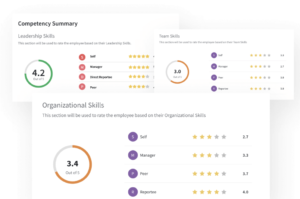General
5 Types of Feedback and How to Use Them in a Workplace
Article written by Jaby K J
Growth Marketer at SurveySparrow
9 min read
24 June 2025

60 Seconds Summary:
69% of employees would work harder if they felt better recognized through effective feedback. Yet most workplaces rely on outdated, generic feedback approaches that miss the mark entirely.
Once you understand that feedback is strategic communication, you will start using feedback to transform your workplace culture, boost employee engagement, and drive organizational growth.
Discover 5 essential types of feedback that create lasting impact, real workplace transformation stories. Keep reading!
Let’s imagine walking into work every day never knowing if you’re succeeding or failing. That’s the reality of millions of employees worldwide who receive little to no meaningful feedback about their performance.
Feedback can make or break a workplace. It’s the difference between a stagnant environment where mistakes go uncorrected and a thriving atmosphere where growth and innovation are encouraged.
But what if I told you that feedback isn’t just about giving and receiving criticism? What if feedback was a way to build stronger relationships, foster creativity, and promote well-being? That’s certainly food for thought, isn’t it?
As American businessman and author Ken Blanchard once said, ‘Feedback is the breakfast of champions.’ And just like breakfast fuels the body, feedback fuels the mind and spirit, promoting productivity, creativity, and overall job satisfaction. But with so many different types of feedback available, it can be challenging to know which one to use and when.
In this blog, we will explore the transformative power of feedback in the workplace, which results in employee satisfaction and reduces turnover rates.
If you are on the hunt for types of feedback, you have come to the right place! So, grab a cup of coffee and get ready to discover the untapped potential of types of feedback in creating a workplace that people actually want to be a part of. Are you ready?”
- What Is Feedback?
- What are the Different Types of Feedback in the Workplace?
- What Is 360 Degree Feedback?
- Features of SurveySparrow’s 360-Degree Employee Feedback Tool
- Why Businesses Should Consider Using SurveySparrow’s 360-Degree Feedback
- Wrapping Up
What Is Feedback?
Feedback is a response to a particular action, behavior, or performance. It is a way of evaluating and providing information about an individual’s performance or behavior. Feedback is essential in any context where improvement and growth are desired.
In the workplace, feedback refers to the process of providing employees with constructive comments, critiques, or evaluations about their work performance or behavior.
The goal of giving feedback is to help employees improve their work performance, foster their development, and to help them achieve the company’s objectives. Effective feedback can also help employees feel recognized, motivated, and engaged, leading to increased job satisfaction and productivity.

What are the Different Types of Feedback?
Positive Feedback
Positive feedback is a type of feedback that focuses on an employee’s strengths and successes. It is crucial in creating a positive work environment and boosting employee morale. Positive feedback can be given in different ways, such as verbal recognition, public acknowledgment, or written communication.
Providing positive feedback is an effective way to reinforce good behavior and motivate employees to continue performing at their best.
For instance, when an employee completes a task exceptionally well, their manager can provide positive feedback by acknowledging their efforts and expressing their appreciation. This can help boost the employee’s confidence and motivation, improving performance.
Constructive Feedback
Constructive feedback is a type of feedback that focuses on an employee’s areas of improvement. It is essential to help employees learn and grow in their roles. When providing constructive feedback, it is crucial to be specific, respectful, and actionable.
For example, instead of telling an employee that their presentation was terrible, a manager could give them constructive feedback on how to improve their presentation skills, such as using more visual aids or practicing their delivery. This type of feedback can help employees understand what they need to work on and how to do it effectively.

Negative Feedback
Negative feedback is a type of feedback that addresses areas of an employee’s work that need improvement. It is vital to provide negative feedback constructively, respectfully and solution-focused. Instead of criticizing an employee for making mistakes, negative feedback can be used to help them learn from their mistakes and improve their performance.
For example, a manager could give negative feedback to an employee who has consistently missed deadlines by providing specific examples of missed deadlines and offering solutions to help the employee manage their time more effectively.
Peer Feedback
Peer feedback is a type of feedback that comes from colleagues or team members. It is important because it can promote teamwork, collaboration, and growth. Peer feedback can be given in various forms, such as one-on-one feedback or team feedback. It is crucial to be respectful, specific, and helpful when giving peer feedback.
For example, when giving peer feedback, one could start by acknowledging the employee’s strengths and then provide specific feedback on areas of improvement. Peer feedback can help employees understand how their colleagues perceive them and what they can do to improve their performance.
Managerial Feedback
Managerial feedback is the feedback that comes from an employee’s manager. It is vital to help employees understand expectations, improve their performance, and advance in their careers. Managerial feedback should be clear, consistent, and actionable.
For example, when providing managerial feedback, a manager could provide specific examples of an employee’s performance and offer solutions to help them improve. Managerial feedback can help employees understand how they perform in their roles and what they need to do to advance in their careers.
Manager Feedback Survey Template
Use This TemplateAfter learning about the types of feedback, do you still want to know what is trending regarding the most performing and responsive employee feedback tool? Here’s the answer you’ve been looking for!
360 Degree Employ Feedback Tool
A highly effective approach to managing feedback in the workplace, encompassing all the previously mentioned types of feedback, is through 360-degree feedback. This method has become increasingly important in promoting employee engagement and improving workplace culture.
What Is 360 Degree Employee Feedback?
360-degree feedback is when employees receive feedback from their supervisor, colleagues, and subordinates. It’s a comprehensive approach to feedback that provides an employee with a well-rounded view of their performance.
This type of employee feedback is often used in performance appraisals and can help employees identify areas of improvement they may not have been aware of. It also gives employees a sense of accountability and helps build trust among team members.

The feedback is gathered through a survey that is designed to assess the employee’s performance across a range of areas, such as communication skills, teamwork, leadership, and job-specific skills. The survey is typically anonymous to encourage honesty and candor.
If you’re looking for an employee feedback tool that offers unique features and a modern design, SurveySparrow is a perfect choice. With its conversational interface, SurveySparrow engages employees in a natural dialogue that feels more like a conversation than a survey.
Features of SurveySparrow’s 360-Degree Employee Feedback Tool
How Does SurveySparrow’s 360-Degree Feedback Work?
SurveySparrow’s 360-degree feedback platform allows businesses to gather feedback from multiple sources and provide employees with actionable insights. It allows businesses to create customized surveys that can be tailored to meet their specific needs. The surveys are designed to be user-friendly, with clear and concise questions that are easy to understand.
The platform also provides businesses with various reporting and analytics tools that make tracking employee performance over time easy. The reports can be used to identify trends, track progress, and provide employees with personalized feedback that is specific to their needs.

Why Should Businesses Consider Using SurveySparrow’s 360-Degree Feedback?
There are many reasons why businesses should consider using SurveySparrow’s 360-degree feedback platform. Here are just a few:
- Improved Productivity: By providing employees with a well-rounded view of their performance, businesses can help them identify areas for improvement and take action to improve their skills and productivity.
- Foster Growth: 360-degree feedback can help employees develop new skills and take on new challenges, which can lead to personal and professional growth.
Build a Positive Work Culture: By encouraging open and honest feedback, businesses can build trust and accountability among team members, which can help foster a positive work culture. - Identify Talent: By tracking employee performance over time, businesses can identify high-performing employees and provide them with opportunities for advancement.
- Enhance Communication: 360-degree feedback can help to enhance communication between team members and promote collaboration and teamwork.
A personalized walkthrough by our experts. No strings attached!
Wrapping Up
We know effective feedback drives business success. Companies that consistently act on these feedback build stronger customer relationships, boost employee engagement, and overall make better decisions.
The key is choosing the right feedback tools and using them regularly. Quality feedback strategies help organizations adapt quickly to market changes and stay competitive.
Want to be successful? Try getting feedback consistently and more importantly act on it. Create systems where feedback leads to visible improvements, encouraging more honest input from your stakeholders.
Ready to strengthen your feedback strategy? Try tools like SurveySparrow, now is the perfect time to use them.
Start 14 Days free trial

Jaby K J
Once chasing a half-cooked Ph.D. dream in Literature amidst the stacks of academia, Jaby has successfully pivoted to become a product marketer in the SaaS industry, leveraging a rich background in research and a deep understanding of creating compelling narratives.
Frequently Asked Questions (FAQs)
The main types are positive feedback, constructive feedback, negative feedback, peer feedback, and managerial feedback. Each serves a different purpose for growth and improvement.
Give positive feedback right after you notice good work or improvement. It reinforces the behavior and motivates people to keep it up.
Be specific about the behavior, explain why it matters, and suggest a way to improve. Focus on actions, not personality.
Address issues quickly and privately. Explain the impact, ask for their perspective, and work together on a solution.
Yes! Peer feedback helps team members learn from each other, improves teamwork, and often brings up helpful insights managers might miss.
Related Articles

Customer Experience
Top Customer Experience (CX) Conferences to Attend in 2025
12 MINUTES
29 November 2019

Reputation management
7 Talkwalker Alternatives for Small Business Analytics in 2025
19 MINUTES
23 June 2025

Best Of
The Best Employee Onboarding Experiences Ever
11 MINUTES
29 January 2021

Work Culture
How to Set up a Home Office: A Guide to Work from Home Effectively
11 MINUTES
15 July 2020
